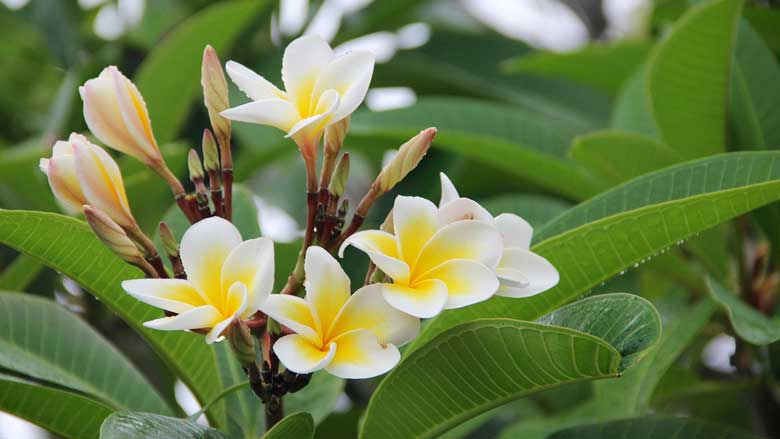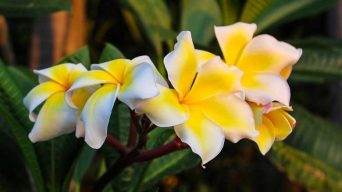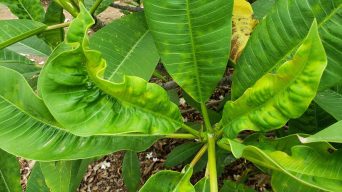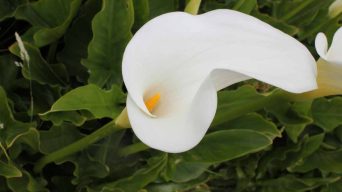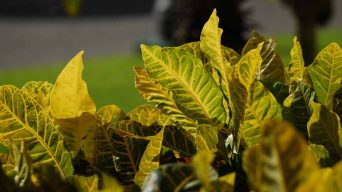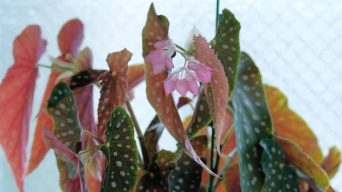Yellowing Plumeria leaves often indicate overwatering, underwatering, nutrient deficiency, pests, inadequate sunlight, extreme temperatures, poor soil, overfertilization, transplant shock, root rot, fungal infection (Plumeria rust), or natural aging. Correct identification and treatment of the underlying cause are crucial.
Many gardeners adore the vibrant blooms of Plumeria flowers.
However, yellowing leaves, a common issue for growers, can mar this beauty.
Fortunately, there are numerous straightforward solutions to this problem.
This article will delve into the 13 most common causes of yellowing Plumeria leaves and provide practical solutions to address them.
Causes and Solutions for Yellow Plumeria Leaves
Native to tropical regions, Plumeria plants are popular in indoor and outdoor gardens and are celebrated for their stunning and fragrant flowers, which are available in various colors.
However, growers often encounter an issue with these plants – yellowing leaves. While this is a widespread problem, there are numerous effective solutions.
Let’s dive into the 13 top causes of yellow Plumeria leaves and discuss how to address this concern.
1. Excess Water
Plumeria yellow leaves often indicate overwatering. This excess moisture can suffocate the leaves, causing them to turn yellow.
If you notice this change, inspect the roots for signs of waterlogging. Soggy roots are a clear indication of excessive watering.
Plumeria plants thrive in well-drained soil that maintains slight moisture.
To assess the plant’s watering needs, check the soil’s moisture level.
Water your plant only when the soil feels dry. Remember, overwatering is a frequent issue; always verify the soil’s dryness before watering again.
Remedying Overwatering
If the leaves are already turning yellow, stop watering and let the soil dry out.
Plumerias are drought tolerant and can survive long periods without water, so do not be afraid to let the soil dry out completely.
Once the soil is dry, you can resume watering, but be sure to water only when the soil is dry.
Withholding water will help the plant recover from overwatering and prevent the leaves from turning yellow.
2. Insufficient Water
Plumeria leaves may turn yellow due to a lack of water.
They are native to tropical and subtropical regions and need regular watering, especially when the weather is hot and dry.
When the leaves don’t have enough water, they can’t function properly and turn yellow.
Plumeria should be watered deeply, about once a week, to ensure the roots get enough moisture.
Addressing Underwatering
If the leaves turn yellow due to a lack of water, start watering the plant more frequently.
Water deeply, about once a week, and ensure the soil around the plant is moist but not soggy.
You may need to water more often in a hot or dry climate.
3. Nutrient Deficiency
Plumeria leaves may turn yellow due to a nutrient deficiency.
The most common nutrient deficiencies that cause yellowing are a lack of nitrogen, phosphorus, or potassium.
Plumeria plants need these nutrients to stay healthy and produce new growth.
A lack of these nutrients can cause the leaves to turn yellow and eventually drop off the plant.
Nutrient deficiency can be caused by poor soil quality, inadequate fertilization, or leaching from too much watering.
Correcting Nutrient Imbalances
If Plumeria leaves turn yellow due to a nutrient deficiency, the best solution is to fertilize the plant.
Use a balanced fertilizer that contains nitrogen, phosphorus, and potassium.
Fertilize every two weeks during the growing season.
You can also amend the soil with compost or manure to improve its quality and help the plant get nutrients.
4. Pest Problems
The most common pests are scale insects and mealybugs.
These pests suck the sap from the leaves, causing them to turn yellow and eventually drop off.
Plumeria plants are also susceptible to spider mites, which can cause the leaves to turn yellow and become covered with webbing.
Pests can also transmit diseases that can cause Plumeria plants to turn yellow.
Managing Pest Infestations
If the Plumeria plant turns yellow due to pests, the best solution is to treat the plant with neem oil.
Neem oil is a natural pesticide that kills and prevents pests from returning.
You can also use insecticidal soap or horticultural oil to control pests.
This treatment should be repeated every week until the pests are gone.
5. Inadequate Sunlight
Leaves typically turn yellow due to a lack of light.
Plumeria is native to tropical regions and requires at least six hours of bright light daily to thrive.
When plants are grown in lower light conditions, the leaves produce less chlorophyll, which gives the leaves their green color.
As a result, the leaves may turn yellow or even brown.
Optimizing Light Exposure
If Plumeria foliage turns yellow due to a lack of light, the best solution is to move the plant to a brighter location.
It should be grown in an area that receives at least six hours of bright light daily.
Moving the plant outdoors during summer ensures it gets enough light if possible.
When indoors, it can be placed near a south- or west-facing window or under grow lights.
6. Extreme Heat
Plumeria, native to tropical regions, thrives in warm weather.
However, its thin and delicate leaves are vulnerable to extreme heat. When exposed to excessively high temperatures, Plumeria leaves turn yellow.
This yellowing is a protective response to prevent further damage to the plant. If the heat persists, the leaves will eventually dry and fall off.
Thus, yellowing is an early indicator of heat stress in plants.
Mitigating Heat Stress
If Plumeria leaves yellow from excessive heat, relocating the plant to a cooler spot is advisable.
Ideally, grow your plant in an area where temperatures range from 60-80 degrees Fahrenheit.
Should temperatures rise excessively, move the plant outdoors or to a cooler indoor space.
Avoid placing the plant in direct sunlight, which leads to leaf yellowing and potential burning.
7. Cold Damage
Plumeria, a flowering plant native to tropical and subtropical regions, has leaves sensitive to cold temperatures.
Frost damage causes these leaves to turn yellow, eventually leading to their death.
Growing Plumeria in areas with temperatures above freezing is crucial to prevent frost damage.
Protecting Against Frost
If frost exposure occurs, moving the plant to a warmer location, indoors or in a greenhouse, is the best preventative measure.
In regions prone to frost, safeguarding Plumeria plants is essential.
This can be achieved by covering them with a tarp or blanket during expected frost periods, protecting the leaves from the cold.
8. Overfertilization
Yellowing leaves in Plumeria plants often indicate overfertilization.
While fertilizers are essential in providing nutrients for plant growth, excess can be detrimental.
Overfertilization leads to yellow and then brown leaves, which eventually fall off. It can also inhibit blooming.
Balancing Fertilization
To address overfertilization, flushing the soil with water is recommended.
This process helps remove excess fertilizer from the root area.
During the growing season, fertilize your Plumeria plants bi-weekly but in moderation.
A small amount of fertilizer is sufficient for their needs.
Proper fertilization practices will ensure your plant remains healthy and vibrant.
9. Poor Soil Composition
One significant cause of yellowing in plants is suboptimal soil quality.
Plumeria thrives in well-drained, sandy soil.
Conversely, if planted in overly dense or poorly draining potting soil, the plant’s roots struggle to access essential oxygen and water.
This stress can lead to yellowing and eventual death of the leaves.
Improving Soil Quality
To remedy yellowing caused by inadequate soil, repotting the Plumeria in well-drained, sandy soil is crucial.
Repotting every two years is recommended for optimal growth and nutrient absorption.
10. Transplant Shock
Transplant shock is a common cause of yellowing in Plumeria plants.
These plants, native to tropical and subtropical regions, are sensitive to relocation.
The transplanting process can disturb and damage their roots, leading to shock. This stress manifests in the leaves, which may curl, turn yellow, and die.
Easing Transplant Recovery
To aid recovery from transplant shock, it’s crucial to allow Plumeria plants ample time to acclimate to their new environment. The ideal time for transplanting is during the warmer months of spring or summer.
Refraining from fertilizing the plant during the initial adjustment period is important. After a few months of acclimatization,
Plants typically begin to recuperate, evidenced by the revival of green foliage.
11. Root Rot
Root rot, a common cause of yellowing Plumeria plants, stems from excessive watering and inadequate drainage.
Continuously wet conditions lead to the rotting of roots, resulting in the plant’s illness, yellowing leaves, and eventual leaf death. To diagnose root rot, examine the roots; mushy or black roots are telltale signs.
Initially, root rot may appear minor, affecting only a few roots, but without prompt intervention, it can rapidly spread and be fatal to the Plumeria.
Treating Root Decay
When root rot is the culprit for yellow leaves, removing the damaged roots and repotting the Plumeria in well-drained, sandy soil is vital.
Additionally, repotting plants every two years is recommended to maintain their health and provide essential nutrients.
12. Fungal Infection: Plumeria Rust
Plumeria rust, a fungal disease, targets Plumeria plants, causing their leaves to yellow.
It originates from tiny, orange spots on the foliage. If not controlled, it can rapidly spread, potentially killing the plant.
Combating Rust
To combat this, remove and destroy any yellowed leaves immediately.
Treat the plants with a fungicide to halt further spread.
Additionally, isolate infected indoor plants to prevent cross-contamination among healthy plants.
13. Natural Aging
Sometimes, Plumeria leaves turn yellow and fall off as part of their natural life cycle.
Plumeria plants are deciduous, meaning they lose their leaves in the winter and grow new ones in the spring.
Plumeria leaves will turn yellow and fall off in the winter when the weather gets cold.
This is normal, and Plumeria plants will grow new leaves in the spring when the weather gets warm again.
If Plumeria leaves are turning yellow and falling off due to the plant’s natural life cycle, there is no need to worry. Plumeria plants will grow new leaves in the spring.
Plants Leaves Turning Yellow in Winter: Causes and Solutions
Healthy and green Plumeria leaves are a sight to behold, but yellowing leaves signal trouble.
These tropical plants struggle in cold weather, with low temperatures often causing Plumeria plants to turn yellow. Sunlight is also crucial; insufficient sun exposure leads to yellow leaves.
Moreover, Plumeria thrives in well-drained soil; overly wet or acidic conditions can result in yellowing.
While regular watering is essential, Plumeria requires less water in winter compared to summer. Inadequate watering can cause the plant leaves to turn yellow and even fall off.
Understanding and addressing these issues can help maintain your Plumeria’s vibrant green foliage.
Reasons Behind Yellowing and Leaf Drop in Plumeria Plants
Plumeria plants exhibit leaf yellowing and drop due to various factors. Insufficient watering is the primary cause, particularly in their active growth phase during summer. Regular watering is crucial for their health.
Conversely, overwatering or excessive sun exposure can also lead to yellowing leaves and their subsequent drop.
Additionally, inadequate sunlight may cause similar symptoms. It’s important to note that leaf yellowing and shedding are natural parts of the plumeria’s life cycle.
As deciduous plants, Plumerias lose their leaves in winter and regrow them in spring.
Yellow Plumeria Leaves with Brown Spots: Causes and Care
Brown spots on Plumeria leaves can be caused by several factors.
One common cause is a fungal disease known as anthracnose, which leads to leaf browning.
Additionally, sunburn can cause brown spots, particularly on new leaves that haven’t yet hardened off. Leaf spot diseases are another culprit, resulting in brown or black spots on the foliage.
To prevent these brown spots, it’s essential to water Plumeria plants at their base, avoiding overhead watering and ensuring they receive adequate air circulation.
If your Plumeria is already affected by brown spots, applying a fungicide may help mitigate the issue.
Final Thoughts
Plumeria leaves can yellow for several reasons, ranging from nutrient deficiencies and pest infestations to diseases or transplant shock.
Sometimes, yellowing is a natural part of their lifecycle, leading to leaf drop. Identifying the cause is key; once you understand the underlying issue, you can appropriately address it with proper plant care.

